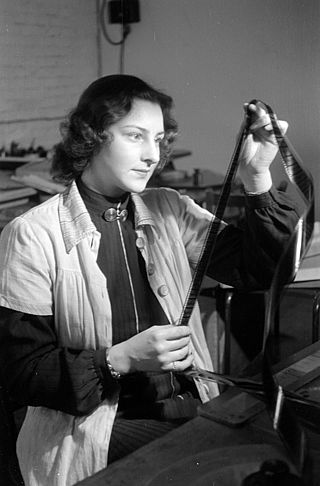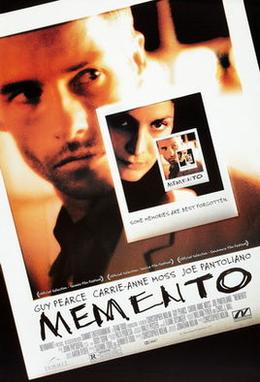In fiction, continuity is the consistency of the characteristics of people, plot, objects, and places seen by the audience over some period of time. It is relevant to many genres and forms of storytelling, especially if it is long-running.

Film editing is both a creative and a technical part of the post-production process of filmmaking. The term is derived from the traditional process of working with film which increasingly involves the use of digital technology. When putting together some sort of video composition, typically, you would need a collection of shots and footages that vary from one another. The act of adjusting the shots you have already taken, and turning them into something new is known as film editing.

A point of view shot is a film scene—usually a short one—that is shot as if through the eyes of a character. The camera shows what the subject's eyes would see. It is usually established by being positioned between a shot of a character looking at something, and a shot showing the character's reaction. The POV technique is one of the foundations of film editing.

In film and video production, split screen is the visible division of the screen, traditionally in half, but also in several simultaneous images, rupturing the illusion that the screen's frame is a seamless view of reality, similar to that of the human eye. There may or may not be an explicit borderline. Until the arrival of digital technology, a split screen in films was accomplished by using an optical printer to combine two or more actions filmed separately by copying them onto the same negative, called the composite.

The Balducci levitation is a levitation illusion first described by Ed Balducci. Its inventor is unknown. It is an impromptu magic trick, which has been popularized by many magicians, such as David Roth, Paul Harris, and David Blaine.

A jump cut is a cut in film editing that breaks a single continuous sequential shot of a subject into two parts, with a piece of footage removed to create the effect of jumping forward in time. Camera positioning on the subject across the sequence should vary only slightly to achieve the effect. The technique manipulates temporal space using the duration of a single shot—fracturing the duration to move the audience ahead. This kind of cut abruptly communicates the passing of time, as opposed to the more seamless dissolve heavily used in films predating Jean-Luc Godard's Breathless, which extensively used jump cuts and popularized the technique in the 1960s. For this reason, jump cuts are considered a violation of classical continuity editing, which aims to give the appearance of continuous time and space in the story-world by de-emphasizing editing, but are sometimes nonetheless used for creative purposes. Jump cuts tend to draw attention to the constructed nature of the film. More than one jump cut is sometimes used in a single sequence.
Diegesis is a style of fiction storytelling in which a participating narrator offers an on-site, often interior, view of the scene to the reader, viewer, or listener by subjectively describing the actions and, in some cases, thoughts, of one or more characters. Diegetic events are those experienced by both the characters within a piece and the audience, while non-diegetic elements of a story make up the "fourth wall" separating the characters from the audience. Diegesis in music describes a character's ability to hear the music presented for the audience, in the context of musical theatre or film scoring.
In filmmaking, a double is a person who substitutes for another actor such that the person's face is not shown. There are various terms associated with a double based on the specific body part or ability they serve as a double for, such as stunt double, "dance double", "butt double" and "hand double".

In filmmaking, the 180-degree rule is a basic guideline regarding the on-screen spatial relationship between a character and another character or object within a scene. The rule states that the camera should be kept on one side of an imaginary axis between two characters, so that the first character is always frame right of the second character. Moving the camera over the axis is called jumping the line or crossing the line; breaking the 180-degree rule by shooting on all sides is known as shooting in the round.
Creative geography, or artificial landscape, is a film editing technique invented by the early Russian filmmaker Lev Kuleshov sometime around the 1920s. It is a subset of montage, in which multiple segments shot at various locations and/or times are edited together such that they appear to all occur in a continuous place at a continuous time. Creative geography is used constantly in film and television, for instance when a character walks through the front door of a house shown from the outside, to emerge into a sound stage of the house's interior.

Cheech and Chong's Next Movie is a 1980 American comedy film directed by Tommy Chong and the second feature-length project by Cheech & Chong, following Up in Smoke, released by Universal Pictures.
This article contains a list of cinematic techniques that are divided into categories and briefly described.

Memento is a 2000 American neo-noir psychological thriller film written and directed by Christopher Nolan, based on the short story "Memento Mori" by his brother Jonathan Nolan, which was later published in 2001. The film stars Guy Pearce, Carrie-Anne Moss, and Joe Pantoliano. The film follows Leonard Shelby (Pearce), a man who suffers from anterograde amnesia—resulting in short-term memory loss and the inability to form new memories—who uses an elaborate system of photographs, handwritten notes, and tattoos in an attempt to uncover the perpetrator who killed his wife and caused him to sustain the condition.
"Han shot first" refers to a controversial change made to a scene in the film Star Wars (1977), in which Han Solo is confronted by the bounty hunter Greedo in the Mos Eisley cantina. In the original version of this scene, Han shoots Greedo dead. Later versions are edited so that Greedo fires at Han first. Director George Lucas altered the scene to give Solo more justification for acting in self-defense. Many fans and commentators oppose the change, feeling it weakens Solo's characterization. The controversy is referenced in the 2018 film Solo: A Star Wars Story.
Screen direction is the direction that actors or objects appear to be moving on the screen from the point of view of the camera or audience. A rule of film editing and film grammar is that movement from one edited shot to another must maintain the consistency of screen direction in order to avoid audience confusion.

An eyeline match is a film editing technique associated with the continuity editing system. It is based on the premise that an audience will want to see what the character on-screen is seeing. An eyeline match begins with a character looking at something off-screen, followed by a cut of another object or person: for example, a shot showing a man looking off-screen is followed by a shot of a television. Given the audience's initial interest in the man's gaze, it is generally implied on the basis of the second shot that the man in the first was looking at the television, even though the man is never seen looking at the television within the same shot.

The over-the-shoulder shot is a camera angle used in film and television, where the camera is placed above the back of the shoulder and head of a subject. This shot is most commonly used to present conversational back and forth between two subjects. With the camera placed behind one character, the shot then frames the sequence from the perspective of that character. The over-the-shoulder shot is then utilised in a shot-reverse-shot sequence where both subject's OTS perspectives are edited consecutively to create a back and forth interplay, capturing dialogue and reactions. This inclusion of the back of the shoulder allows audiences to understand the spatial relationships between two subjects, while still being able to capture a closer shot of each subject’s facial expression. In film and television, the filmmaker or cinematographer’s choice of an OTS shot’s camera height, the use of focus and lenses affect the way audiences interpret subjects and their relationships to others and space.

A film —also called a movie, motion picture, moving picture, picture, photoplay, or flick—is a work of visual art that simulates experiences and otherwise communicates ideas, stories, perceptions, emotions, or atmosphere through the use of moving images that are generally accompanied by sound and other sensory stimulations. The word "cinema" is a shortening of the word "cinematography" and is used to refer to either filmmaking, the film industry, the overall art form, or a movie theater.
Post-classical editing is a style of film editing characterized by shorter shot lengths, faster cuts between shots, and containing more jump shots and close-ups than classical editing characteristic of films prior to the 1960s.
This glossary of motion picture terms is a list of definitions of terms and concepts related to motion pictures, filmmaking, cinematography, and the film industry in general.












